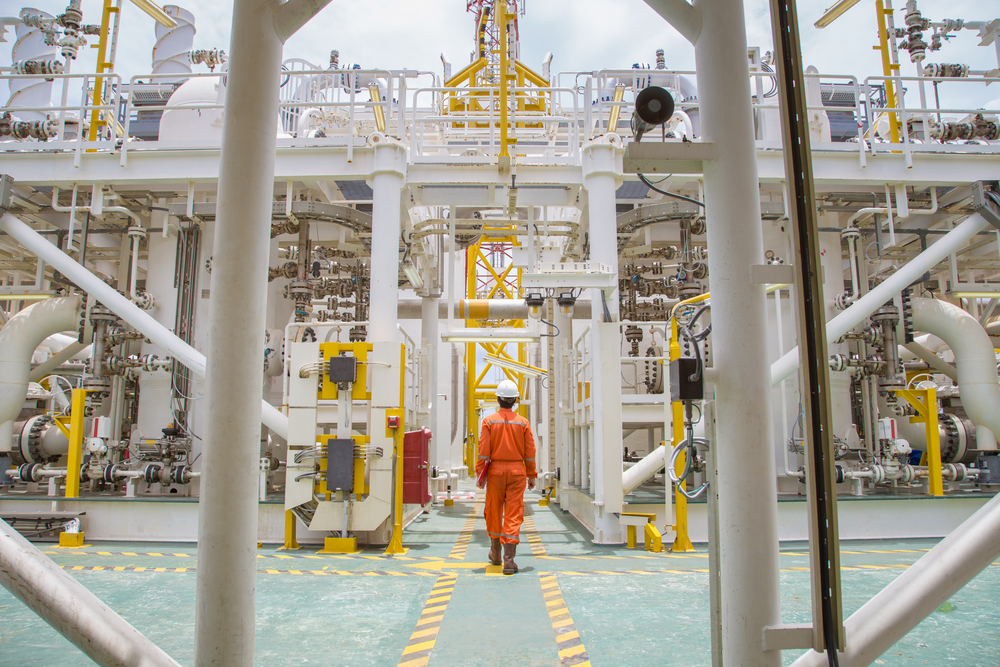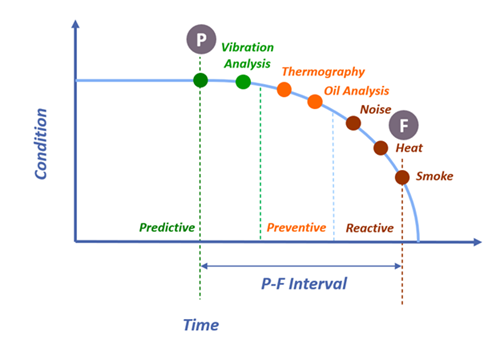What is Condition Based Maintenance?

Reduce unscheduled downtime and keep your machines safe with a condition-based maintenance system
What Is Condition Based Maintenance?
Condition based maintenance is one of four ways to manage rotating and reciprocating machines at a plant. The four methodologies that are used to manage and operate machinery are Run to Failure, Preventative Maintenance, Predictive Maintenance and Proactive Maintenance. A brief definition of each is down below.

Image 1 – Comparison of Various Maintenance Methodologies
1. Run to Failure – The most expensive way to operate. Run the machine until it fails then replace it. This is usually used only when the machine does not impact plant production.
2. Preventative Maintenance – Repairs to the machines are made on a periodic basis, regardless of the machines condition. Oftentimes, the preventative repairs are more damaging to the machine than if the machine was left alone – this is the next most expensive way to operate.
3. Predictive Maintenance – Repairs to the machines are made based on the condition of the machine. This is condition-based maintenance. It is based on predictive technologies like vibration monitoring, thermal imaging, lubrication analysis and ultrasonic analysis – this is one of the least costly ways to operate but needs a consistent investment in permanent monitoring via transmitters integrated with the existing Control System (PLC’s, SCADA, RTU’s, etc.).
4. Proactive Maintenance – Repairs to the machine are made based on the condition of the machine. This is also a condition-based maintenance methodology. It is based on predictive technologies like thermal imaging, lubrication, and ultrasonic analysis, combined with continuous vibration monitoring with data correlation with the plant process parameters of pressure, flow, power level, capacity, etc. – this is the least costly way to operate, but has the highest initial startup cost.
Metrix advocates a vibration monitoring solution that makes economic sense for the machine’s impact on the plant. For critical production limiting machines we advocate a sensor solution that monitors each bearing or throw, thrust, and speed on rotating or reciprocating machinery. For non-critical rotating or reciprocating machinery that marginally affects plant production, we advocate a minimal sensor solution for monitoring and protection, or depending upon the asset, an electronic or mechanical switch for protection.
Our solution depends upon the customer’s cost of Unscheduled Downtime. Unscheduled Downtime caused by a problem coming from a rotating or reciprocating machine is the costliest for a plant. The plant loses money from lost profits (Lost Opportunity Cost = loss of profitable output), expedited repair, material and labor costs, standby labor costs, quality issues, customer trust / delivery issues, and most importantly personnel safety concerns.
Condition Based Maintenance Examples

Image 2: P-F Curve

Condition based maintenance helps machinery work well and last past its expected lifespan. Some of the most common forms of condition based maintenance you might come across include:
1. Vibration Monitoring
Vibration monitoring is a method of condition-based maintenance that measures specific vibrations and patterns of a machine. It can monitor a single component or the entire machine, depending on what you want to be alerted to. Using a vibration sensor, the incoming vibration is transferred into electrical data that is then sent to the monitoring or control system. If the system recognizes differences or issues in the data, it alerts you that maintenance is needed.
The most used vibration sensors on rolling element bearing machines are vibration transmitters, and depending on the frequencies of interest, they can be accelerometer or velocity based transmitters. If the machine is a fluid film bearing machines, proximity sensors or transmitters are used for vibration monitoring.
2. Thermography
Thermography is a test that uses an infrared camera to detect heat patterns. When the infrared camera is pointed at a machine, the differences in heat can be sensed using a thermographic map in two dimensions (2D). Some cameras are sensitive enough to actually assign temperatures to the various regions. From a condition monitoring standpoint, the same thermographic pictures can be taken month after month to see if there are any significant changes. Large changes in temperature can be considered abnormal and cause for further investigation.
3. Lube Oil Analysis
Lube oil analysis is based on wear particles in the lubricating fluid. Depending on the wear particle density and chemical composition, components in the machine can be trended over time. Changes in wear particle density are indicators of increased machine wear. From a condition monitoring standpoint, lube oil analysis can often be paired with thermography and vibration monitoring to confirm a machine issue like a bearing problem.
4. Sound Analysis
Sometimes we think the noise from a machine is just noise, but sound analysis has shown that one can determine possible bearing defects in the ultra-frequency range (> 20 KHz). Its often very good to determine pre-failure of a bearing (all rolling element bearings will eventually fail) but caution has to be used on when to remove the bearing from service. Taking out the bearing in the pre-failure stage could be a major waste of money since there could be many years of service left on the bearing.
Benefits of Using Condition Based Maintenance
When it comes to rotating and reciprocating machinery, there is a great deal of equipment that needs to be monitored to make sure it functions properly. The benefits of using a condition monitoring system on your machines include:
1. Reduced Downtime
One of the biggest reasons companies use condition based maintenance systems on their equipment is to avoid potential unscheduled downtime. When a machine goes down that’s a part of your business, it not only costs your company time, but it costs you money too. By having a machine health monitoring system that you can trust, you can expect reduced equipment downtime, especially unscheduled downtime.
2. Extended Machine Life
A monitoring system watches your machine’s health and alerts you to any new changes in its normal monitoring profile. Then by taking preventive action, your machine can function more efficiently, avoid damage, and ultimately have a longer lifespan.
3. Prevention of Increased Damage
A condition based maintenance system can help avoid potential damage to your rotating and reciprocating machinery by alerting you and shutting the equipment down if necessary. This way, even if there was an alert that occurred from an initial issue, because the monitoring system has the ability to shut the machine off, it prevents damage and potential dangers that could occur from a failure.
4. Reduced Maintenance
Preventative measures like condition based maintenance help to cut down how often maintenance is needed by tracking your machine’s health. By notifying you when there are small disruptions, it allows you to catch issues right in their tracks. With less maintenance needed, your company can save money.
Using Condition Based Maintenance Today
At Metrix Vibration, we know just how crucial it is to keep your machines working their best. That’s why we offer a variety of vibrational monitoring tools to help you manage and monitor the different equipment throughout your company. Rotating and reciprocating machinery needs to be monitored carefully to avoid potential danger or damage, and that is exactly where a vibration monitoring system comes in.
Reduce unscheduled downtime and keep your machines safe with a condition based maintenance system. If you have any questions about our solutions, don’t hesitate to contact our team.
By Everett Jesse, Vice President of Sales and Marketing
